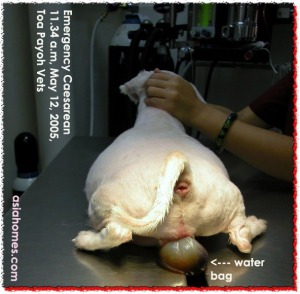Pulse rate down
"The dog's pulse rate is below normal!" Dr D of Practice
X suddenly said. " I have to take the temperature." She
took a thermometer and proceeded to the back of the
operating table. Her pulse measurement machine flashed
the figures but I was too pre-occupied in helping Dr A
to get the 3rd puppy out as fast as possible.
This was Dr A's first Caesarean section and as she had
requested me to be present, I must ensure that the
clinical outcome for her Caesarean section must be good.
That meant the dam and puppies must be alive.
"A Caesarean section surgery in a dog can be completed
in around 15 minutes when you are more experienced," I
had earlier said to her. "Today, you would take more
than 30 minutes."
Now we were interrupted. With the pulse dropping as
measured by the instrument, the dam would surely die.
Therefore Dr D wanted to take the rectal temperature to
assess the overall health.
As Dr D walked briskly to the end of the table, I asked
the young lady: "How are you going to take the rectal
temperature when we are in the middle of a Caesarean
section? The dog is draped and it is not so easy to
insert the thermometer into the anus under the drape."
She realised that it was impossible to stop the
Caesarean train now but what should she do?
"Reduce the isoflurane gas to 1% and increase the
oxygen flow rate to 3 litres per minute for a few
minutes," I advised. She did so accordingly and was
satisfied that the pulse rate went back to normal soon.
She would adjust the isoflurane maintenance dose to
around 2% later. The anaesthesia was excellent
throughout the surgery.
Visiting Vet, Dr B who had 4 more years of experience
than the operating vet did not advise in the drama of
the dropping pulse rate. However he remembered my advice
as he recounted this episode to me when I had a staff
meeting. Neither did visiting Vet Technician Dr C. They
all waited for me as I was the most senior vet.
Dr B did make one comment earlier saying that "Too many
cooks spoil the broth" when the Visiting Vet Technician
Dr C advised a longer and lower incision in the uterus.
I had shown the operating vet where to make the first
incision in the uterus but Dr C said it should be lower
down the bifurcation. And a longer incision.
Dr B had also encouraged the operating vet by saying:
"Once you have done one Caesarean, you will be able to
do others."
In this situation, my visiting vets should be quiet so
as not to distract the operating vet and contradict my
teaching. But they were friends and so I did not stop
them giving their two cents' worth of advice.
It is not pleasant to shut them as they bring in their
own experiences in other practices to share together. I
do learn something from them too as no vet knows all.
P.S
Vet Technicians in Singapore are mainly veterinary
graduates from the Philippines and Myanmar. However they
are not certified to practise veterinary medicine in
Singapore, but in their countries they are professional
veterinary surgeons.
The following
topics would be of interest to the students:
1. Anaesthetic machines. Know how they work. Close
circuit. Semi-closed circuit. What size of
re-breathing bag to use for puppies? For adult
dogs. Why are there two pressure gauges from the
oxygen cylinders? One is to measure the oxygen
tank pressure. The other is to indicate the volume
of oxygen in the tank. Scavenging systems.
Emergency drugs. Emergency oxygen button.
Emergencies and what to do? I presume you will be
tested during examinations later. Pre-anaesthetic
doses, blood screening.
2. Round-bodied and tapered suture needles. Sizes.
Type. Cat gut, absorbable and non-absorbable
sutures. |
Example 1.
In this case study, I noted that the anaesthetic
re-breathing bag used was around 500 ml. This was
not good for big dogs. I advised the use of 1-litre for
the adult dog. When the staff switched to another
circuit with the bigger re-breathing bag, I presumed
that the female dog would be breathing isoflurane gas
when given through a mask.
After more than 3
minutes, the female dog was still awake and alert. "It
is strange," I said. "The female dog should be sleepy."
I had incorrectly assumed that the staff had done the
connections properly.
Example 2.
Pre-anaesthetic medication. "Should I use the
pre-anaesthetic injection for the Caesarean section?"
the operating vet asked me as she took out a vial of
colourless liquid.
I advised no. Isoflurane gas by mask is usually
acceptable by the female dog with dystocia. In this
case, she did not struggle. Some vets do give
pre-anaesthetic injections prior to isoflurane gas. For
vets without the gas, injections may lead to the death
of puppies.
Example 3.
Suture packets with a black circle indicate that the
cross-section of the needle is
round. Such sutures
are used for the stitching of inner tissues such as the
muscles, bladder and uterus. If there is a triangular
circle, the sutures are for skin stitching.
The young
students nowadays will not have seen the popular TV
series "Have Gun Will Travel." This was a case of
"Have Caesareans Will Travel," as I had to go out of Toa
Payoh Vets to handle the case. I expect it to be a
simple routine Caesarean section with plenty of helping
hands and the surgery would be over in 15 minutes.
Things don't
alw ays
turn out as anticipated. ays
turn out as anticipated.
Some of Dr
Sing's Caesarean section cases are at;
Caesareans Toa Payoh Vets
Caesarean section cases
|
 TOA
PAYOH VETS
TOA
PAYOH VETS TOA
PAYOH VETS
TOA
PAYOH VETS